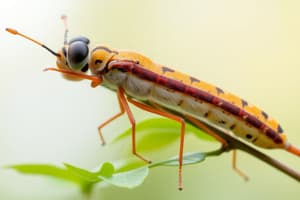Podcast
Questions and Answers
What is the science of naming and classifying organisms called?
What is the science of naming and classifying organisms called?
- Genetics
- Ecology
- Taxonomy (correct)
- Biology
The method of naming organisms using a two-word system is called ______.
The method of naming organisms using a two-word system is called ______.
binomial nomenclature
What are the three domains of life?
What are the three domains of life?
Bacteria, Archaea, Eukarya
Which kingdom includes unicellular, prokaryotic organisms with a cell wall?
Which kingdom includes unicellular, prokaryotic organisms with a cell wall?
All plants are multicellular and autotrophic.
All plants are multicellular and autotrophic.
What is the primary difference between prokaryotic and eukaryotic cells?
What is the primary difference between prokaryotic and eukaryotic cells?
Which kingdom is primarily composed of organisms that are mostly unicellular and eukaryotic?
Which kingdom is primarily composed of organisms that are mostly unicellular and eukaryotic?
Match the following kingdoms with their defining characteristics:
Match the following kingdoms with their defining characteristics:
Flashcards are hidden until you start studying
Study Notes
Methods of Classification
- Classification includes 10 to 30 million living eukaryotic species.
- Taxonomy is the science of naming and classifying organisms based on structural and genetic comparisons.
- Categories include Domain, Kingdom, Phylum, Class, Order, Family, Genus, and Species.
- Common names can lead to inaccuracies and may vary by location.
- Aristotle initiated a classification system focused on characteristics, later refined by Linnaeus with binomial nomenclature.
- Binomial nomenclature uses the genus name followed by the species name, providing a standardized naming system with Latin.
- Organisms exhibit physical classification traits, demonstrated by the Platypus, which shares features with both birds and mammals.
- Modern taxonomy incorporates phylogenetic trees to illustrate evolutionary relationships.
- Evolutionary relationships show that the Platypus is more closely related to Opossum than Duck.
- Xenotransplantation involves organ, tissue, or cell transplantation between different species.
The Kingdoms
- Organisms are categorized into three domains: Bacteria, Archaea, and Eukarya.
- The six kingdoms are Eubacteria, Archaebacteria, Protista, Fungi, Plantae, and Animalia.
- Eubacteria and Archaebacteria are unicellular and prokaryotic, but Archaebacteria often thrive in extreme conditions.
- Characteristics of kingdoms are based on body type (unicellular or multicellular), cell type (prokaryotic or eukaryotic), cell structure, and nutritional methods (autotrophic or heterotrophic).
- Kingdom Eubacteria: Unicellular, prokaryotic, cell wall with peptidoglycan, can be photosynthetic or disease-causing.
- Kingdom Archaebacteria: Unicellular, prokaryotic, cell wall, found in extreme environments, both autotrophic and heterotrophic.
- Kingdom Protista: Mostly unicellular, eukaryotic, varies in cell wall presence, includes organisms that don’t fit into other eukaryotic kingdoms.
- Kingdom Fungi: Unicellular or multicellular, eukaryotic, heterotrophic, cell wall made of chitin, important decomposers.
- Kingdom Plantae: Multicellular, eukaryotic, autotrophic, cell wall made of cellulose, species size ranges from 1 mm to 115 m.
- Kingdom Animalia: Multicellular, eukaryotic, heterotrophic, lacks a cell wall, includes invertebrates and vertebrates.
Types of Plants
- Reasons to group plants include distinguishing types, characterizing features, understanding their roles in the ecosystem, and tracing evolutionary history.
Studying That Suits You
Use AI to generate personalized quizzes and flashcards to suit your learning preferences.




